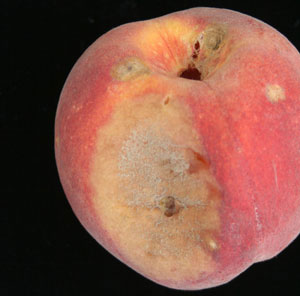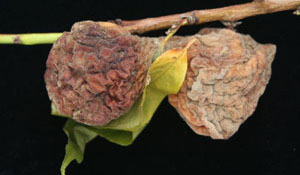Brown Rot
HOSTS
- Cherry
- Peach/Nectarine
- Plum
DESCRIPTION
Brown rot is a disease of warm, humid environments and requires several hours of rainfall to spread and cause infections. The two most susceptible periods for fruit infection are the blossom stage through peach pit hardening, and the two to four week period before harvest.
BIOLOGY
The brown rot pathogen overwinters on previously infected fruit, called "fruit mummies". Spores are blown by wind and rain to infect flowers on ripening fruit.
The pathogen can enter fruit when any type of injury caused by insect damage, hail/heavy rain injury, bird pecks, bruising, or cracking, is present.
On ripening fruit, symptoms first appear as a small tan spot that quickly enlarges (within 2 to 5 days) until the whole fruit rots. If conditions remain moist, a mass of light grey-brown spores will form on the fruit surface. Fruit that is left on the tree will shrivel and dry out. This mummified fruit will carry spores over the winter, increasing the risk of blossom infection the following spring.
SYMPTOMS
- Mass of light grey-brown spores on fruit surface
- Shriveled, wrinkled fruit
GENERAL MANAGEMENT
Remove all infected fruit from the trees and ground. Mowing over them can help to prevent overwintering survival. Fungicides can help to control brown rot, but should only be used when the pathogen has been identified. (Other rots can look similar) Where brown rot is a problem, fungicides should be used after petal fall and close to harvest if the weather is cool and rainy during those times.



